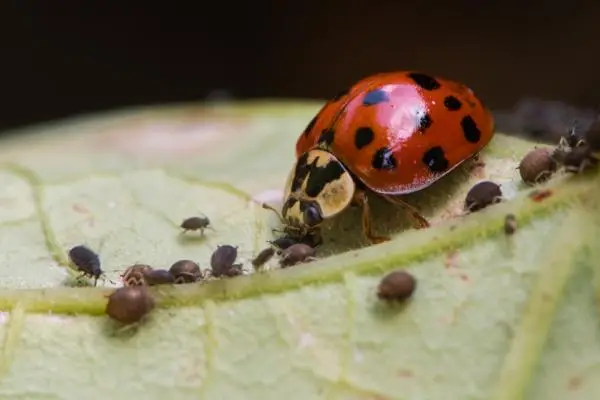The control of pests with chemical products has many disadvantages, including its great cost and the risk of contamination that it entails, both for food and for the environment and our health. For this reason, biological pest control is revealed as an ecological and very effective alternative, especially in the long term.
If you want to learn more about biological pest control, what it is, advantages, disadvantages and examples , then keep reading this article.
What is biological pest control
In the biological control of pests , what is used to kill the species considered pests is nothing more than the introduction of some of their natural predators in the plantation. In this way, it is possible to eliminate the plague without the need to use chemical products of any kind and, in addition, without a harmful impact on the product or the environment.
Biological pest control came into use in 1880, when Rodolia cardinalis , a species of ladybug, was imported to the US from Australia to fight cornered mealybug. The success of the measure, which resulted from permanent effects and a tremendously favorable cost-effectiveness despite the initial investment, caused this type of pest control to begin to gain support.
Among the biological pest control strategies , three basic ones are distinguished:
Import
Import consists of the introduction of the organism that will be the biological control agent . Although a priori it may seem something very simple, making the introduction in an adequate and controlled way requires deep knowledge and a studied strategy. Because of this, biological pest control is one of the methods that requires more knowledge.
Increase
The increase consists of taking measures so that the natural enemies of the pest to be eliminated see their population strengthened. It can be used both on indigenous agents and on others released by import and, although it was traditionally considered very expensive, currently its costs are increasingly affordable, due to the increasing number of specialized companies that are dedicated to the release and inoculation of controlling agents.
Conservation
Finally, conservation consists of trying to implement measures that help maintain populations of natural enemies . It is the least studied strategy and the most complex to apply, since it requires a deep understanding of the functioning of the agroecosystem.

Advantages of biological pest control
The main advantages of biological pest control are that:
- It allows to fight against these without having to resort to insecticides or pesticides, products that are toxic and harmful to both human health and the natural environment.
- Furthermore, this method has a permanent effect in many cases, thereby providing the best of long-term effects.
- Its cost-effectiveness ratio is also skyrocketing and, although it requires initial investments that are sometimes expensive, in the long run it is the most economical of the pest control methods.
Disadvantages of biological pest control
Of course, this method has drawbacks as well. Thus, these are the main disadvantages of biological pest control :
- As we have already mentioned, its most important drawback is that it requires action plans, strategies and, in general, much more knowledge than other simpler application methods.
- Its action time is notably slower than pesticides, since you have to wait for the predator to settle and multiply to kill the pest.
- When used in conjunction with other forms of control, such as pesticides, pesticides intended to kill pests may also affect the population of the controlling biological agent.
Examples of biological pest control
Apart from the case described above about ladybugs and grooved mealybugs, this insect being also effective against pests such as the cottony mealybug and also aphids , these are two very simple examples of biological pest control :
The white fly
This insect, which tends to attack plantations of tomatoes, cucumbers, beans, peppers and tobacco, causes great damage to crops due to its rapid spread, which is also usually accompanied by the attack of fungi and viral infections. The most common agent to use in combat is the Encarsia formosa fly . This small parasite (approximately 1 mm) lays its eggs in whitefly larvae, causing them to become parasitic that continue to spread and, in this way, kill the pest that consumes the plants.
Thrips
The trip, a known insect less than 3 mm in size, feeds on the nutrients of the leaves, stems, flowers and fruits of plants, causing tissue necrosis and death. It is fought using the mites Neoseiulus barkeri and Amblyseius cucumeris , which prey on thrips larvae and thus destroy the plague.

